The Study Tour of Japan for European Youth 2007
Kateřina Garajová, Brno, November 2007
In October 2007 I participated on Study Tour of Japan for European Youth, a programme organized traditionally by the Japanese Ministry of Foreign Affairs. This programme in the length of 10 days is aimed for young people from the European coutries to come to Japan and learn more about it's culture, politics and daily life.
I was really excited when I discovered that I was chosen to this programme. I've learned Japanese for over two years now but I've never had a chance to visit Japan before. The main goals of the tour weren't only sight-seeing and cultural events. An important aspect of the tour was also gaining a better knowledge on Japanese politics and economy. Both were presented to us in various ways (excursions, lectures) by professionals. The first week of our stay was to be spent in Tokyo and the second one travelling to Hiroshima and in the Kyoto area.
Our first visit was to the Ministry of Foreign Affairs, where Dr. Akima Umezawa held for us a lecture on Japan international relations, with the focus on the Japan-European cooperation.
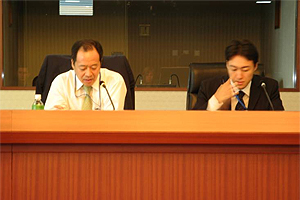
Lecture on Japan-European relations on Ministry of Foreign Affairs with Dr. Akima Umezawa, Principal Deputy Director of European Policy Division, MFA (left), Mr. Daichi Yamada, the coordinator of the Programme (right)
Then we visited the Diet (Japanese Parliament), where our guide took us to see the House of Representatives. I was also very impressed when we were shown the chamber, where the Emperor rests while staying in the House of Representatives.
In Nippon Keidanren, the Japanese Business Federation, we learned more about Japanese economy and about the strong and direct influence of the Federation on the decision-making of Japanese government, which was for me a truly surprising discovery. The Keidaren is in fact a Federation uniting the biggest Japanese companies, most of which are major players on the international markets. An important part of Japanese economy is based on the highly developed technology, and we visited one of the Japanese top hi-tec companies, Panasonic in the Tokyo Panasonic Center.
On the other hand we were also shown an example of family run small-scale company with few employees, a metal spinning manufacture Kitajima-Shibori. The president, Mr. Kitajima himself, told us some basic information about their production. In the office we saw many prizes the company received over the years one of their products even was used while building a spaceshuttle. After the tour around the factory we could try for ourselves making one of the metal spinning products. Although their techology is unique (supposedly there's no competion in whole Japan), unlike the big international concerns we visited earlier, the company still had to struggle day by day to keep their customers.
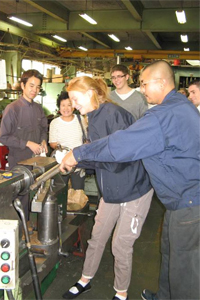
Kitajima-Shibori manufacture
The first night of our stay in Tokyo we attended to a welcome reception prepared for us in our hotel. There were invited representatives from the embassies of the programme participant's counties, as well as some students from Tsuda College and other guests. I had the opportunity to speak to Mr. Trojáček from the Czech Embassy about Japanese economy.
We were given the opportunity to experience first hand some of the most famous aspects of Japanese culture. All of those were things that Japanese culture is worldwide known for but in reality this knowledge is usually only very superficial. In the first place we it was an ikebana lesson at Sogetsu-Kaikan. Our lecturer showed us five different styles of flower arrangement, creating wonderfull flower decorations withing few minutes. When we had the chance to try it ourselves, it wasn't all that easy as our instructor made it look before.
One evening we had the chance to see one of the highlights of Japanese theatre, a performance in Kabuki-Za in Tokyo. As our guides explained us, we were quite lucky, since that night the main characters were performed by two biggest stars of the Kabuki theatre scene, which was a rare opportunity. I must say I knew very little about Japanese theatre, so it was hard for me to imagine it. The performance was nothing like the Western theatre plays and what was very surpising for me were the reactions from the audience during the play. Later I learned that they were calling out the names of their favourite actors as a sign of their admiration. Friday morning we attended the tea ceremony at Urasenke Tokyo-Dojo. Urasenke is one of the main tea schools in Japan and has been taught even abroad. The tea ceremony had a very unique atmosphere.
The drum concert performed by the Nagisa Taiko group was astonishing and the music so lively and upbeat. We tried playing the drums ourselves and it was rather difficult. I really admired the childern playing with the group. After the concert a delicious japanese-style refreshment was prepared by the families and friends of Nagisa Taiko drummers.
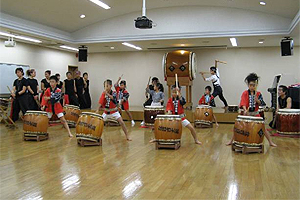
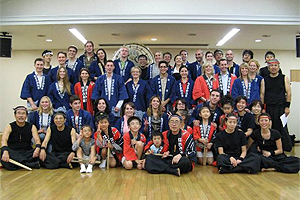
Nagisa Taiko Drum concert
During our visit to Tsuda College, one of the oldest private all girl colleges in Japan we atteneded to a lecture about the stereotypes of defining a "typical Japanese". Just as the lecture shown, we all picture the typical Japanese based on a rather superficious common observations as the always busy but successful salaryman. In reality, the truth is completely different, already staring with the fact that the majority of Japanese population is female. After the lecture we separated into discussion groups in which we talked with the college students about various topics based on our preferences. I chose a group where we discussed the Japanese culture. We spoke about how the traditional culture is seen by the Japanese young people, how is the modern culture influenced by the West and also how Japanese culture expands in Europe. We've seen that one hand the Japanese culture nowadays is strongly influenced mainly by American model, but on the other hand the European culture takes from Japanese culture both tradional (ikebana, martial sports) and modern (manga, anime, music).
The second week of our tour, started with an over-night home stay in Hiroshima. We spent only a little time with the host families but I felt that despite the time being too short the welcome that avaited us was no less warm. At first I think there was a little bit of hesitation and shyness on both side, but it was dissolved very quickly. My host family, the Yoshimotos, was a young couple with a 10 year old daughter, Mayuki. We went to visit Miyajima with Itsukushima shrine near Hiroshima. It's an UNESCO site with a large temple complex and a rare torii on the shore standing in the water at the tide. In the evening we drove back to Hiroshima to Yoshimoto's house where we talked and exchanged presents till late night. I helped Mayuki with her homework – she was supposed to talk in the class about my visit to their family. I wrote some lines in Czech in her notebook and then she wrote the translation of it in Japanese. The following morning was unfortunatelly time leave. After our home stay programme finished we went to visit the Hiroshima Peace Memorial Museum. What amazed me the most was the fact that the tragedy of Hiroshima isn't forgotten like it happen in the Western countries, but all the Japanese elementary school children are taught about it and it's significance. On my walk in the Peace Memorial Museum Park at first I was really surprised to be surrounded by a group of school children who gave me their peace messages, paper cranes and asked me to sign the peace proclamation, but then it made me realize how much is Japanese attitude towards the WWII different from our western "history-book" knowledge. After the tour we attended a talk of one of the A-bomb survivors. He spoke about his personal experinece, not from the point of view of a politician or historician, but a common citizen who survived the horrors of the A-bomb. It was very moving to listen to his story.
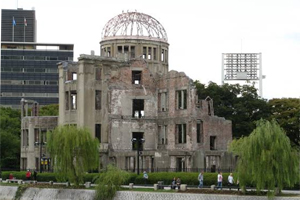
Aatomic dome, Hiroshima

Talk of A-bomb survivor
After leaving for Hiroshima by shinkazen, we went to see the most famous sight-seeing attractions in the Kyoto and Nara, which are famous for their wonderful historical sites and gardens. In Kyoto itself it was the Arashiyama area with the Tenryu-ji temple and peaceful bamboo groves. Our next visit was dedicated to the Nijo Castle, the stone Zen garden in Ryoan-ji and the golden pavillion, Kinkaku-ji. The end of our second week was dedicated to the UNESCO National Heritage sites in Nara, first it was the world's oldest wooden structure, temple complex of Horyu-ji and Todai-ji, the world's largest wooden structure with an impressive, almost 15m tall, statue of Buddha.
The study tour of Japan was a wondeful experience for me, something I woudn't be able to experience otherwise. I had an unique opportunity to have a glimpse on life in Japan and also to try practice a little bit my Japanese. I realized how little I know, but it really stimulated me to pursue my studies of Japanese and possibly try to apply for a scholarship. Our guides Mrs. Morita and Mrs. Murakawa were like our mothers. They took very good care of us and whenever we had any problems they tried their best to help us solve them. Thanks to their organization skills every part of our programme went smoothly. I'd like to help to promote further the Japanese culture in my country, for example by helping in the Japan Center just recently established in Brno. I hope we'll manage to make Japan more popular among the Czechs and draw them into a more profound interest in Japanese culture.
Kateřina Garajová
Brno 26th November 2007